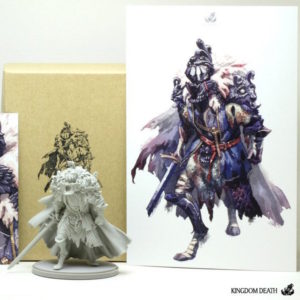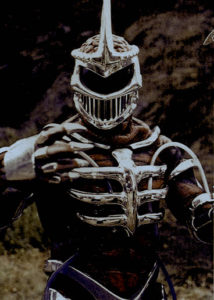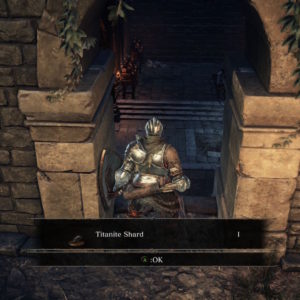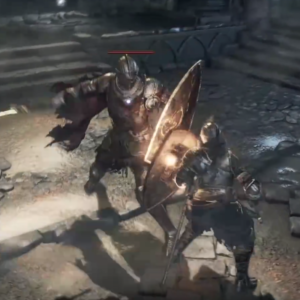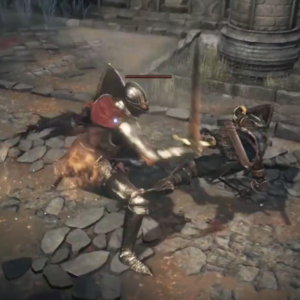
5 of 7 core monsters with 4 prologue survivors
Though I heard about the first Kingdom Death Kickstarter when it launched in 2012 and adored the aesthetic, A) I do not really play board games and B) I had no experience assembling miniatures. So, I passed. However, after seeing some of the models in the wild, I took advantage of the Black Friday 2015 opportunity and bought a copy of the core game along with the Sunstalker and Flower Knight expansions. The game arrived early January 2016 and then it sat on my shelf unassembled for almost a year. The 1.5 reprint/update Kickstarter prompted me to actually attempt assembly. It took me a few weeks to assemble the four prologue survivors and all the core monsters.
Overview
It is surprisingly hard to find a concise description of the game. Here is my attempt. It is a cooperative campaign board game where four survivors wake up barely clothed in an unlit land. The ground is all stone faces. The survivors hunt monsters for resources and found a settlement near a pile of creepy lanterns. Players grow the settlement, building structures, developing innovations, and reproducing. They stave off inevitable entropy for as long as possible.
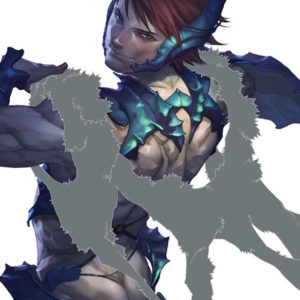
Male dung beetle dancer pinup concept art
You have to assemble complex components yourself without any official instructions (though the community stepped up enthusiastically to fill this void). The art is beautiful, but the aesthetic includes sexual objectification, gore, and puerile humor that mixes the two. You will need to have friends that are okay with this if you want to play the game with other people. Your survivors start weak and fragile, similar to zero level characters in trad D&D terms. Rule zero of the game is when in doubt, rule against the survivors. Pinups like the one to the right are promotional items, not part of the game. (I am not interested in discussing opinions on the representation of sexuality or objectification in this game.)
Gameplay
Gameplay alternates between tactical combat and settlement building. More specifically, after the first story prologue fight that introduces basic concepts, the cycle is settlement, hunt, and showdown. This cycle constitutes one lantern year (the time it takes one of the creepy settlement lanterns to burn out). A full campaign in the core game is 20 lantern years. I think a reasonable real-world session would be one or two lantern years generally, but I do not yet have extensive experience. During my first play (we were four players), we did the prologue and lantern year one. This took about four hours but included taking cards out of shrink and looking up lots of rules. I think it would be significantly faster the second time. Note that you also have to assemble some miniatures first, though you can get by with only the white lion and four survivors to begin with (see remarks on assembly below).
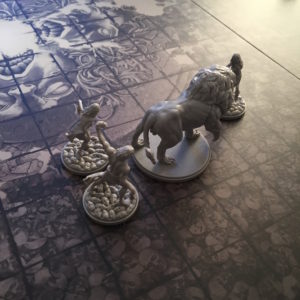
Hitting from behind!
Showdown Phase. The showdown phase (where you fight monsters) is straightforward two-dimensional tactical combat. Move some spaces, take an action. The showdown board is small enough that it seems like few turns would be movement-only (I consider this a good thing). Players rotate controlling the monster though the monster controller needs to make few decisions as the monster actions are mostly dictated by an AI deck.
In addition to the AI deck, each monster has a hit location deck which controls various monster reactions. After survivors hit, they must confirm damage as well (accuracy adds to hit, strength adds to confirming hits). I was worried at first that this might result in many turns where engaging multiple resolution systems would lead to no overall effect, but in practice that did not seem to be a problem. A monster-specific resource deck controls the resources that the monster could potentially yield. Actual drops are determined mostly randomly, though some hit locations give access to specific resources. If the survivors defeat the monster, they scavenge resources which can be used to build things during the settlement phase. Some monster fights use terrain pieces to increase the arena complexity. Overall, the tactical combat is simpler than 4E D&D, one of my few points of comparison (I consider this a good thing).
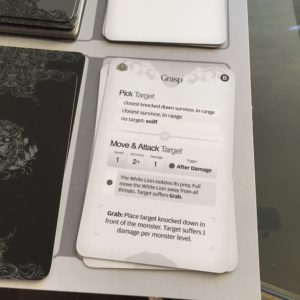
White Lion monster AI card
Monster AI. The AI deck also doubles as the monster health score which means that the monster actions become less variable and potentially more predicable as survivors wear it down. The AI deck system also means that the same monster can be reconfigured in many ways with differing difficulty. For example, we fought the white lion twice, during the prologue and the first hunt. The AI deck construction was different between those two and the construction incorporated randomness. The lion we hunted (level one) had 7 basic and 3 advanced AI cards, randomly selected (this also meant that it had 10 health, though note that you need one final hit to take a monster down after that total is depleted). For me, the AI deck is probably the most compelling game design I have seen so far in Kingdom Death. It is approachable from a player standpoint but seems to generate a lot of emergent complexity. There are many lessons here for D&D monster design, probably best realizable through sets of tables.
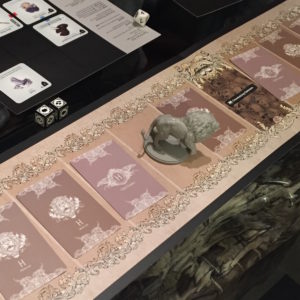
Hunt board
Hunt Phase. Between settlement phases survivors can go on a hunt, though this is not the only way to encounter monsters (encounters can be caused by settlement events also). The hunt, which hopefully culminates in a showdown (briefly described above) plays out on a one-dimensional track where events occur on the way to the monster. In our first hunt, one of our survivors was terrified to death by the screeching and yowling of a lion in heat so we went into the lantern year one fight with only three combatants. This could mean that one player might be out for the showdown. The game is collaborative enough that it might still be fun, but I am not sure (we did the prologue fight with four players but were down to three anyways for the first hunt and showdown). Our first lion hunt ended in a TPK. Since there are still some other survivors left in our settlement, the TPK is not game over.
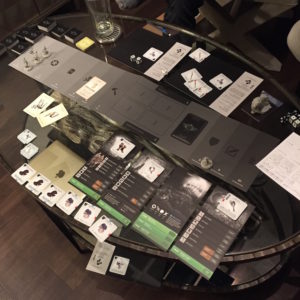
Settlement board
Settlement phase. In some ways the payoff to playing Kingdom Death is the settlement phase. It is sort of like a fun, collaborative, non-homework version of building a character in games that require complicated character builds. However, unlike complex character building, success in the settlement phase depends not on voluminous knowledge of the rules text and combos, but rather on success during previous showdown phases and a few choices about what to prioritize. Also, as discussed below, I think that the settlement is the primary fictional element of play in Kingdom Death, not the survivor. As you can see in the image to the right, the settlement phase also has its own board, which similar to the hunt board is a one-dimensional track that walks players through the procedure.
Prepare to Die
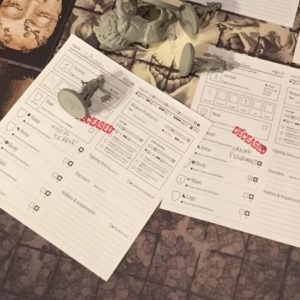
Defeated by ground fighting (TPK)
The survivor is not the primary element of play in Kingdom Death. The settlement is. When you lose a survivor, that is a setback but the settlement’s remaining population acts as a buffer (and the slain survivor’s gear is not lost but automatically returned to the settlement). As I understand it, settlement wipes are certainly possible (though I do not know how common). If you would be frustrated by such a loss after, say, 20+ hours of in-person play rather than experiencing it as the dark closing chapter of a story to remember, this might not be the game for you.
One strain of traditional D&D play is similar to this approach, where the setting and adventuring party are the first-order units of play and the adventurer is, while not disposable exactly, at least not central. I have run games like this before and participated in them and I think that this approach offers a unique potential for engaging play. In such a game, impartially resolved catastrophic failure is possible but not fatal to the campaign, increasing the potential stakes of decisions. Kingdom Death is a far more focused game than D&D but it provides examples that could be adapted to a D&D game centered around developing a party or settlement. In fact, I do not think it would be that hard to run an OD&D game using many Kingdom Death mechanics directly, perhaps replacing magic items and treasure with resource drops and settlement crafting and adapting monster decks to D&D monsters.
Metaphysically Ambiguous Dark Fantasy
Beyond gameplay though, the aspect of Kingdom Death that originally drew my attention, and sustains my interest, is the aesthetic and setting which reminds me of two of my other favorite fantasy franchises, Berserk and Dark Souls. This is not that surprising, as I understand that Berserk is an explicit influence on the designers of Kingdom Death. These three, Berserk, Dark Souls, and Kingdom Death, make up what is for me a dark fantasy trinity. All three have complex, well-designed, internally consistent worlds with ultimately ambiguous canons. There is enough detail to keep my interest but not so much that the audience ever really knows exactly what is going on.
The world of Kingdom Death is an endless plain of stone faces lit occasionally only by lanterns. Why? Where did the survivors come from? Who knows? Despite the detailed and baroque monster design, all three of these franchises also have an ultimately restrained sensibility that rests more on mythical resonance than raw newness. None of the three franchises are shy about recruiting cliches, but the cliches are never used thoughtlessly and often adjusted (though never entirely subverted, which I also appreciate).
For example, the background text for the Black Knight, previously a collectible model but being developed into a game expansion in the current Kickstarter:
They say if you take a lantern that never lit down the trail of corpses and past the whispering stars you will find an ancient figure atop a crest of determined faces. Treasured by a hidden cult of loyal squires, the figure will awaken for only the most honorable of challengers. For generations, the Black Knight has unknowingly defended a settlement of people hidden in the ruins of its home.
Assembly
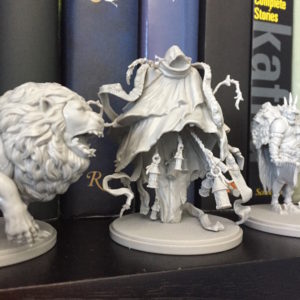
What wraiths look like from now on
These were the first miniatures of any kind that I have ever assembled. As noted above, the mini parts come attached to sprues as cast in the factory and must be clipped out. There are no official instructions, but I found the guidance on Vibrant Lantern satisfactory except for the phoenix and the watcher. I used this one for the phoenix and this one for the watcher (both linked to from Vibrant Lantern). For general advice, I found this conversation useful. Several issues tripped me up that might be obvious to experienced model builders. Below I address some of these issues. Hopefully that will be useful to other gamers with similar levels of experience.
Tools. You need to buy at least two things to assemble the minis: sprue clippers (I got Citadel Fine Detail Cutters, $35) and plastic glue (I used Plasti-Zap, $4). A model file would be helpful to clean up join points but I did without. Another useful tool that I did get was a clamp (Irwin One-Handed 6″ Bar Clamp, $12).
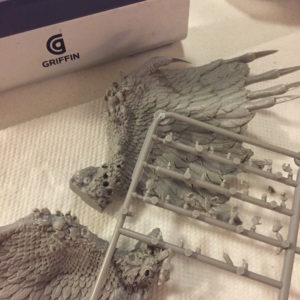
That’s right, those are all individual hands
Glueing. The plastic glue begins to set quickly as long as you do not jostle the pieces, so the technique I found most useful is to find a way for gravity to hold the parts together so that you can go do something else (the clamp can help with this). To be safe, I generally attach a few parts and then let them fully dry overnight before adding anything else. You can have multiple models in progress, but do not clip parts before you are ready to attach them because it would be easy to mixup or lose parts. Assembly was time consuming in a hurry up and wait manner but not exactly difficult. I found the absurd complexity of the process somehow motivating. I used up a full ⅓ oz bottle of Plasti-Zap to assemble four survivors and all seven of the core monsters, so I would recommend buying more than one bottle of glue.
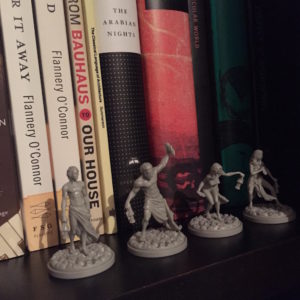
The four prologue survivors
Basing. Each mini base is two parts: bottom and inset. The core game comes with a small number of special face inserts. This is just a cosmetic detail, but you will not have enough for all the minis. I used four of them on the prologue survivors. Hopefully, the 1.5 Kickstarter will include an add-on to get more face inserts. See discussion of stone face bases here and here. There is no special correct placement of minis on bases. Just glue them on however looks reasonable.
Gaps. While most of the parts fit together well, if you are anything like me you will still end up with some fit gaps in the assembled models. The phoenix was the biggest offender here (use more clamp, I guess). I have heard good things about Tamiya Basic Type Putty (which is itself gray) and so will likely look better than Green Stuff before painting. I have not used either of those myself yet.
Expansions
I have not yet used any of the expansions in play, but as I understand it several of the expansions offer alternate campaigns (Dragon King, Sunstalker, and Flower Knight) while others offer monsters that can sub in for core game monsters. The Gorm can be hunted early on (otherwise the White Lion is the only monster that can be hunted during the first few lantern years). The Lantern Festival, which was intended to extend a campaign past 20 lantern years, was cancelled because the designer was not satisfied with how it worked. The Lantern King model is amazing though, so I hope it becomes available in some form. The upcoming Nightmare Ram (available through the new Kickstarter) is intended to offer some sort of dungeon crawl experience. See here for more. It looks to me like the game should play just fine with no expansions. The core game alone, if you dig the style, should provide lots of replay value.
Conclusion
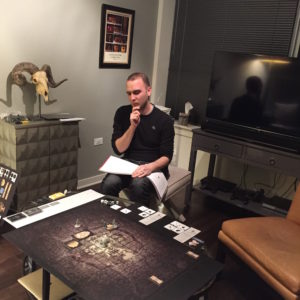
My handsome pal Josh modeling the showdown board
Play was smooth and none of the phases were that complicated. The hardest part of playing the first time is finding the various kinds of cards (there are a lot of different kinds of cards). A few of the mechanics seemed like they could be streamlined in minor ways. For example, weapon and monster accuracy is a target number (used to hit) while strength functions as a bonus that is compared to a toughness target number. Both kinds of stats can have bonuses and penalties. It is also easy to get a few of the stats mixed up (strength versus accuracy, movement versus speed, and so forth).
I never felt like there was choice paralysis, even when we were making decisions about items to craft during the settlement phase. I can see how that might change as you build more settlement locations and have more kinds of resources to draw on but hopefully the complexity increases gradually. I am not yet sure which elements of the game are best served by cards and tokens as opposed to just writing things on record sheets, but so far I am enjoying the physicality of everything. At this point, I am kind of a super-fan of both the world and game mechanics, but I am not blind to the fact that there are a number of drawbacks which make Kingdom Death a big commitment and probably not for everyone.
Additional Resources
Chris Handley’s videos with Beasts of War are the only decent actual play videos I have found. They have so far released lantern year one, lantern year two, lantern year three, lantern year four, and lantern year five (I have not watched all of them yet). Chris’s Instagram has many nice examples of painted models too and is worth checking out for inspiration (and check out his amazing hair!).
Disclaimers
First, I am far from a Kingdom Death expert. That said, I have assembled all the core game monsters and played it, so I can speak to some aspects of setup and play. Hopefully the fact that I am neither a diehard board gamer nor a miniature person might help me speak to other similarly casual gamers that nonetheless find the Kingdom Death vision compelling. Second, I am backing 1.5 for the upgrade pack and some expansions.
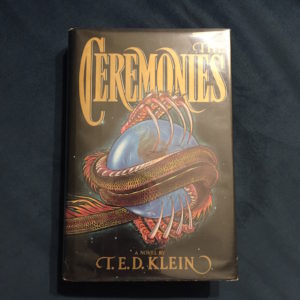 Several years ago, I was looking for highly-regarded recent cosmic horror novels. I asked online and somebody recommended T. E. D. Klein’s novel The Ceremonies. I finally started reading it a few months ago, somewhat distracted by other books and priorities, but made my way through it slowly and finally finished in a few days ago.
Several years ago, I was looking for highly-regarded recent cosmic horror novels. I asked online and somebody recommended T. E. D. Klein’s novel The Ceremonies. I finally started reading it a few months ago, somewhat distracted by other books and priorities, but made my way through it slowly and finally finished in a few days ago.







